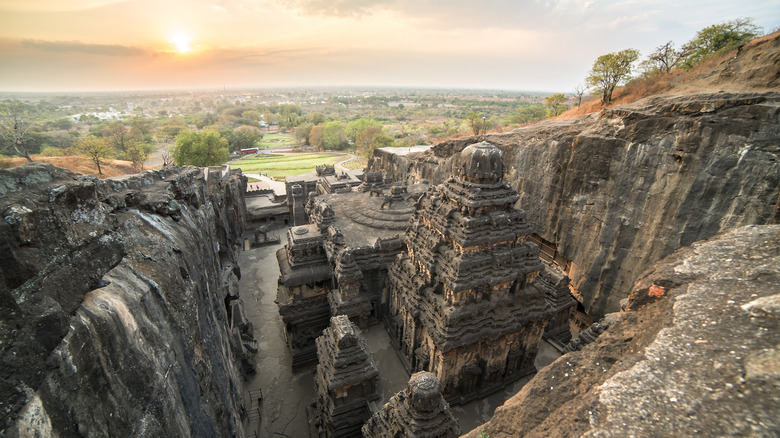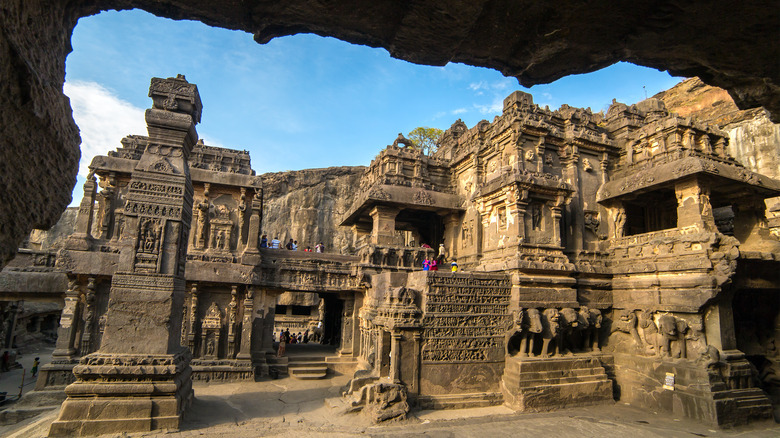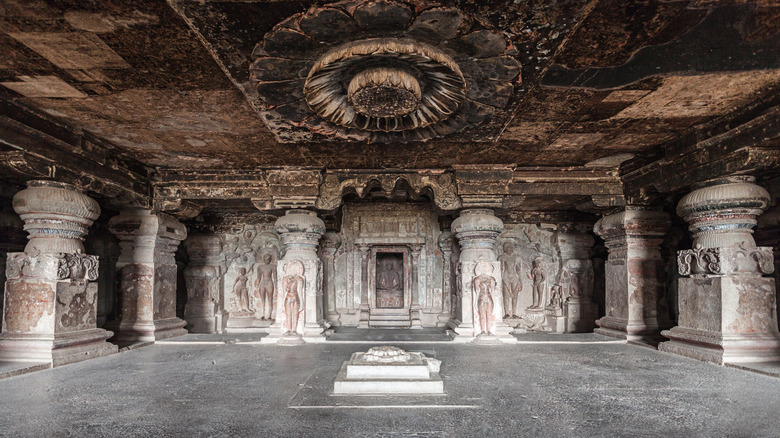The Mysterious Temples Of India's Ellora Caves
Plenty of notable ancient sites around the world get a lot of love from the general public. The Pyramids at Giza (built around 2500 BCE, per National Geographic), Stonehenge (started 3000 BCE, per English Heritage) or the comparatively much newer Taj Mahal (finished 1648 CE, per UNESCO) all come to mind. Such sites represent the creative, organizational, religious, and of course, economic powers of their days. Yet, these big-name brands shouldn't overshadow Earth's whole host of lesser-known, often-underappreciated architectural and cultural marvels.
Take the Ellora Caves of India (pictured above), located less than an hour by car northwest of the city of Aurangabad in the Indian state of Maharashtra. Pictures truly can't do it justice. As a UNESCO Heritage Site, it's a massive, jaw-dropping, intricate complex of 34 "rock hewn" monasteries, temples, and sacred spaces cut into 2 kilometers (about 1.2 miles) of basalt cliffs. The complex was carved directly into the rock face, not built from stone transported from other places. This means that the whole thing, with all of its ornate, decorative columns and structures, reliefs and statues of gods and goddesses, and cavernous interior spaces comprise one single, unbroken piece of stone.
The Ellora Caves don't belong to any one religion or creed. They're a testament to India's incredibly long, multi-faith, multiethnic history. The complex's Buddhist, Hindu, and Jain iconography represent a catch-all in honor of, and in service to, about 1.5 billion living people (via the Pew Research Center).
Hundreds of years of construction and add-ons
As Heritage Daily explains, the 34 individual temples, monasteries, altars and shrines within the Ellora Caves complex can be broken down into 12 Buddhist caves (caves 1-12), 17 Hindu caves (caves 13-29), and five Jain caves (caves 30-34). Even though the precise history of the complex is somewhat of a mystery, the Ellora Caves weren't built overnight. They're the byproduct of hundreds of years of work, passing from king to king and dynasty to dynasty. It stands to reason that the nobility more or less "sponsored" (i.e., paid for) the caves' ongoing construction to serve as a pilgrimage site.
Construction may have started during the Traikutaka dynasty of Gujarat in modern India's west (388-480 CE) and finished as late as 1100 CE in the hands of the Chalukya dynasty. The Hindu caves seem to be the oldest, with the Buddhist and Jain caves coming later. This makes sense, because Buddhism and Jainism were essentially built from populist backlash against the Indian subcontinent's strong caste-based roots, as Time Maps explains.
Modern "India" is an incredibly new state; its constitution went into effect only as recently as 1950 (per History). Before that, India was a collection of disparate kingdoms and shifting borders. Modern Indians often identify more with local states than national identity. Starting about 1608, the region also suffered tremendous colonial meddling, as India Today outlines. This makes the Ellora Caves a fantastic symbol of national unity and shared history.
A temple of legends and myth
Out of the entire Ellora Cave complex, temple 16 — the Kailasa Temple — tends to receive the most attention. Its megalithic form stands tall, proud, and imposing. There are no written records about the temple's construction, but as My Modern Met says, several short written accounts connect the temple to someone named "Krishnaraja." (You might recognize the Hindu deity "Krishna" in the name.)
There's also an old legend associated with the Kailasa temple about a queen trying to restore her husband's health. To do so, she needed to build a temple to the god Shiva, and time was of the essence. Some clever engineer pointed out that if the temple was hewn from the mountain, from the top down, it could be finished in no time. This is how Kailasa temple looks to have been actually constructed.
Because of the skill on display, the Kailasa Temple, and the whole Ellora Cave site by extension, has sadly fallen prey to the tired "It's so amazing, therefore humans couldn't have built it" paradigm posited by shows like the History Channel's Ancient Aliens (via YouTube). Entertaining as such speculation might be, there's really no need to imply that our ancestors were so dumb. After all, they're why we're here.
At present, as Yatra points out, it costs 550 rupees for international visitors (not quite $7.50) to enter the Ellora Caves, and 35 rupees for Indian nationals (less than 50 cents).


